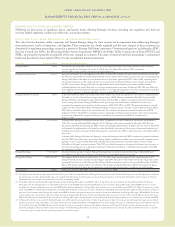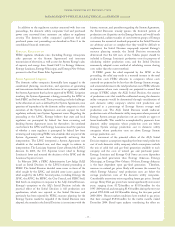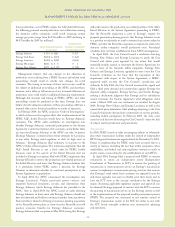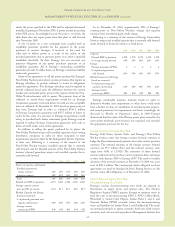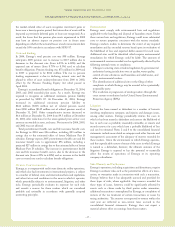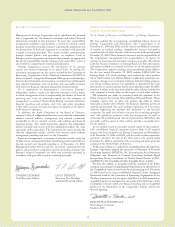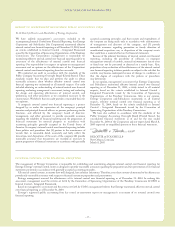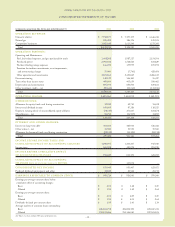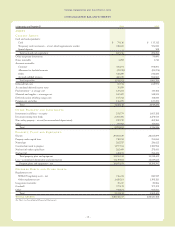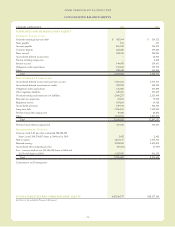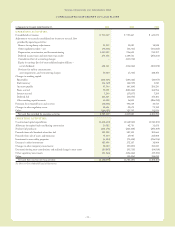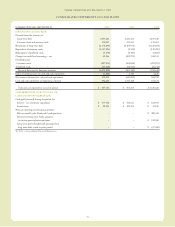Entergy 2004 Annual Report Download - page 45
Download and view the complete annual report
Please find page 45 of the 2004 Entergy annual report below. You can navigate through the pages in the report by either clicking on the pages listed below, or by using the keyword search tool below to find specific information within the annual report.
Entergy Corporation and Subsidiaries 2004
In the first quarter of 2004, Entergy Arkansas recorded a revision
to its estimated decommissioning cost liability in accordance with a
new decommissioning cost study for ANO 1 and 2 as a result of
revised decommissioning costs and changes in assumptions
regarding the timing of when the decommissioning of the plants
will begin. The revised estimate resulted in a $107.7 million
reduction in its decommissioning liability, along with a
$19.5 million reduction in utility plant and an $88.2 million
reduction in the related regulatory asset.
In the third quarter of 2004, Entergy Gulf States recorded a
revision to its estimated decommissioning cost liability in
accordance with a new decommissioning cost study for River Bend
that reflected an expected life extension for the plant. The revised
estimate resulted in a $116.8 million reduction in decommissioning
liability, along with a $31.3 million reduction in utility plant,
a$40.1 million reduction in the related regulatory asset, and a
regulatory liability of $17.7 million. For the portion of River Bend
not subject to cost-based ratemaking, the revised estimate resulted
in the elimination of the asset retirement cost that had been
recorded at the time of adoption of SFAS 143 with the remainder
recorded as miscellaneous income of $27.7 million.
In the thirdquarter of 2004, Entergy’s Non-Utility Nuclear
business recorded a reduction of $20.3 million in its
decommissioning cost liabilityto reflect changes in assumptions
regarding the timing of when the decommissioning of a plant will
begin. Entergy considered the assumptions as part of recent
studies evaluating the economic effect of the plant in its region.The
revised estimate resulted in miscellaneous income of
$20.3 million, reflecting the excess of the reduction in the liability
over the amount of undepreciated asset retirement cost recorded at
the time of adoptionof SFAS 143.
Unbilled Revenue
As discussed in Note 1 to the consolidated financial statements,
Entergy records an estimate of the revenues earned for energy
delivered since the latest customer billing. Each month the
estimated unbilled revenue amounts are recorded as revenue and
a receivable, and the prior month’s estimate is reversed. The
difference between the estimate of the unbilled receivable at the
beginning of the period and the end of the period is the amount of
unbilled revenue recognized during the period. The estimate
recorded is primarily based upon an estimate of customer usage
during the unbilled period and the billed price to customers in that
month, including fuel price. Therefore, revenue recognized may be
affected by the estimated price and usage at the beginning and end
of each period and fuel price fluctuations, in addition to changes in
certain components of the calculation including changes to
estimates such as line loss, which affects the estimate of unbilled
customer usage, and assumptions regarding price such as the fuel
cost recovery mechanism.
Impairment of Long-lived Assets
Entergy has significant investments in long-lived assets in all of its
segments, and Entergy evaluates these assets against the market
economics and under the accounting rules for impairment
whenever there are indications that impairments may exist. This
evaluation involves a significant degree of estimation and
uncertainty, and these estimates are particularly important in
Entergy’s U.S. Utility and Energy Commodity Services segments.
In the U.S. Utility segment, portions of River Bend and Grand Gulf
are not included in rate base, which could reduce the revenue that
would otherwise be recovered for the applicable portions of those
units’ generation. In the Energy Commodity Services segment,
Entergy’s investments in merchant generation assets are subject to
impairment if adverse market conditions arise.
In order to determine if Entergy should recognize an impairment
of a long-lived asset that is to be held and used, accounting
standards require that the sum of the expected undiscounted future
cash flows from the asset be compared to the asset’s carrying value.
If the expected undiscounted future cash flows exceed the carrying
value, no impairment is recorded; if such cash flows are less than the
carrying value, Entergy is required to record an impairment charge
to write the asset down to its fair value. If an asset is held for sale,
an impairment is required to be recognized if the fair value (less
costs to sell) of the asset is less than its carrying value.
These estimates are based on a number of key assumptions,
including:
•Future power and fuel prices - Electricity and gas prices have
been veryvolatile in recent years, and this volatility is expected
to continue. This volatility necessarily increases the imprecision
inherent in the long-term forecasts of commodity prices that are
akeydeterminant of estimated future cash flows. There is
currently an oversupply of electricity throughout the U.S.,
including much of Entergy’s service territory, and it is necessary
to project economic growth and other macroeconomic factors in
order to project when this oversupply will cease and prices will
rise. Similarly, gas prices have been volatile as a result of recent
fluctuations in both supply and demand, and projecting future
trends in these prices is difficult.
•Market value of generation assets - Valuing assets held for sale
requires estimating the current market value of generation
assets. While market transactions provide evidence for this
valuation, the market for such assets is volatile and the value of
individual assets is impacted by factors unique to those assets.
•Future operating costs - Entergy assumes relatively minor annual
increases in operating costs. Technological or regulatory changes
that have a significant impact on operations could cause a
significant change in these assumptions.
-43 -
“Electricity and gas prices have been very volatile in
recent years, and this volatility is expected to continue.”
MANAGEMENT’S FINANCIAL DISCUSSION and ANALYSIS continued



